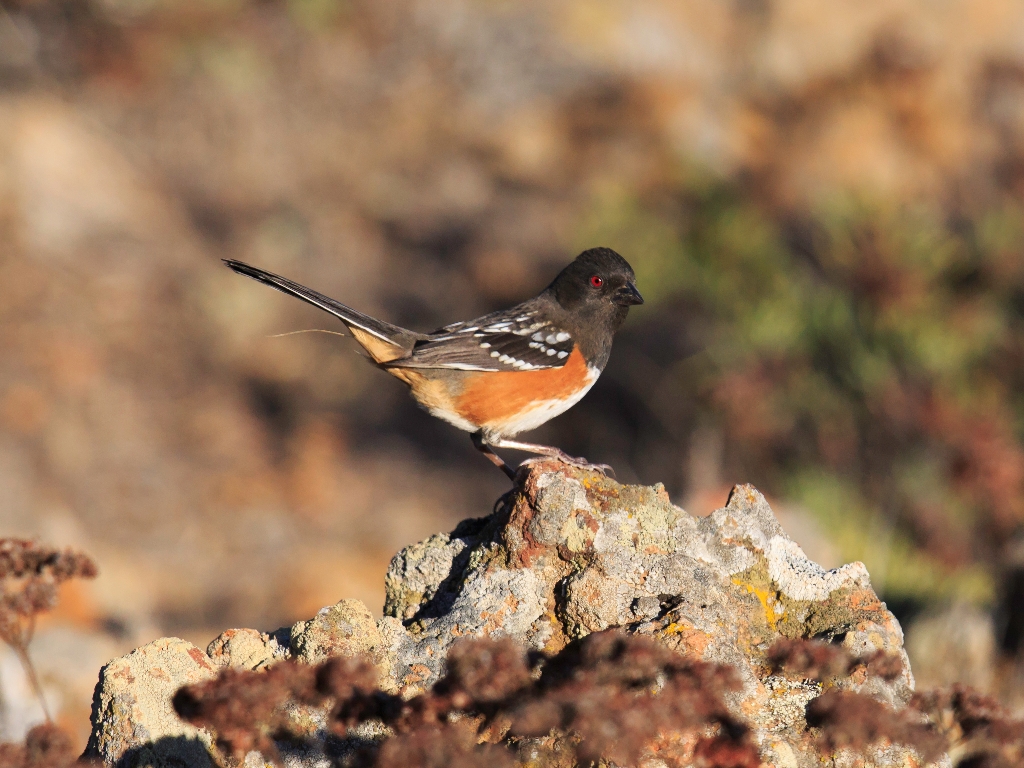| Scientific Name
Pipilo maculatusmegalonyx Introduction
At Channel Islands National Park. spotted towhees (Pipilo maculatus) occur on Santa Cruz and Santa Rosa Islands.The species, which was formerly know as the rufous-sided towhee, ranges from southern Mexico into Canada in western North America. There are over 20 recognized subspecies, and the island birds belong to the subspecies megalonyx, which also occurs in coastal southern California. A separete subspeices (P. m. clementae) inhabits Sant aCatalina Island and formerly occured on San Clemente Island, but was extirpated there by the 1970s. Quick and Cool Facts - While feeding on the ground spotted towhees often use a two-footed, backwards-scratching hopping technique.. This "double-scratching" is used by a number of towhee and sparrow species to uncover the seeds and small invertebrates they feed on.
- During conflicts between two towhees, one bird pick up a piece of twig, bark, or leaf and carry it around. This seems to be an indication of submission.
- Early in the breeding season, male spotted towhees spend their mornings singing their hearts out, trying to attract a mate. Male towhees have been recorded spending 70 percent to 90 percent of their mornings singing. Almost as soon as they attract a mate, their attention shifts to other things, and they spend only about 5 percent of their time singing.
- When disturbed, a nesting female spotted towhee may run away like a mouse rather than fly.
- They occasionally sun themselves, lying down on the grass with feathers spread.
- They often bathe in dew or fog drip on vegetation.
- A group of towhees are collectively known as a "tangle" and a "teapot" of towhees.
- Spotted towhees live in drier habitats than eastern towhees. Some scientists have suggested that the bold white spots on spotted towhees' backs help them blend in to the sun-dappled undergrowth.
- The oldest recorded spotted towhee was 10 years 8 months old.
Appearance
The spotted towhee is a large sparrow with white-spotted black back and black rump. Its breast is black, the belly white, and sides are rufous. The species has a black head with eyes that are red. Distinctively, its wings are black with white spots. It has a tail that is long and black with white corners. The female spotted towhee is duller, with brown instead of black and fewer white spots. Differences between the subspecies, P. m. clementae and P. m. megalonyx, the most locally common of the subspecies, is that clementae is in size slightly greater than megalonyx;its bill and feet appreciably larger. As well, clementae's coloration is grayer than in megalonyx with its black areas in the male duller and less intense.The rump and lower back of clementae is more or less mixed with grayish. Range
Spotted towhees are widely distributed in western North America, occurring from the southern tip of Mexico to southern Canada. The spotted towhee is the most common bird on Santa Rosa Island, according to park landbird studies. Habitat
Spotted towhees are birds of dry thickets, brushy tangles, forest edges, old fields, shrubby backyards, chaparral, coulees, and canyon bottoms, places with dense shrub cover and plenty of leaf litter for the towhees to scratch around in. Data from the park's landbird monitoring program indicates that spotted towhees on Santa Rosa Island favor scrub, grassland and chaparral habitat types. Feeding
Spotted towhees rummage in the leaf litter or creep through thick shrubs. Towhees tend to hop wherever they go, moving deliberately and giving themselves plenty of time to spot food items. They scratch at leaves with a characteristic two-footed backward hop, and then pounce on anything they've uncovered. Reproduction
In the breeding season, spotted towhees eat mainly insects including ground beetles, weevils, ladybugs, darkling beetles, click beetles, wood-boring beetles, crickets, grasshoppers, caterpillars, moths, bees, and wasps. Other leaf-litter arthropods such as millipedes, sowbugs, and spiders are taken as well. They also eat acorns, berries, and seeds including buckwheat, thistle, raspberry, blackberry, poison oak, sumac, nightshade, chickweed, and crops such as oats, wheat, corn, and cherries. In fall and winter, these plant foods make up the majority of their diet. Spotted towhee nests are usually built in depressions on the ground, or occasionally in vegetation 1 ½to 5 feet off of the ground, which are typically overhung with bushes, vines, or clumps of grass that provide shelter and protective screening. The female lays two to six white or gray eggs flecked with purple and red brown that she incubates from 12 to 14 days. Pairs will raise two and occasionally three broods in a single season and will renest following nest failure. Conservation Status
The California Department of Fish and Game has listed the San Clemente spotted towhee, which occurs currently on Santa Catalina Island and formerly occurred on San Clemente Island, as a California Bird Species of Special Concern. Additional Information - PDF of San Clemente Spotted Towhee account from:Shuford, W. D., and Gardali, T., editors. 2008. California Bird Species of Special Concern: A ranked assessment of species, subspecies, and distinct populations of birds of immediate conservation concern in California. Studies of Western Birds Western Field Ornithologists, Camarillo, California, and California Department of Fish and Game, Sacramento
- http://www.allaboutbirds.org/guide/Spotted_Towhee/id
- http://identify.whatbird.com/obj/102/_/Spotted_Towhee.aspx
- http://birding.about.com/od/birdprofiles/p/spottedtowhee.htm
- http://www.catalinaconservancy.org/minisites/animal_species.php?
- http://thewebsiteofeverything.com/animals/birds/Passeriformes/Emberizidae/Pipilo-maculatus
- http://elibrary.unm.edu/sora/Condor/files/issues/v015n05/p0167-p0175.pdf
- Contribution from the Museum of Vertebrate Zoology of the University of California, H.S. Swarth, 1913
- http://www.catalinaconservancy.org/index.php?s=wildlife&p=catalina_resident_bird_list
- Coonan, T.J., R.C. Klinger and L.C. Dye. 2011. Trends in landbird abundance at Channel Islands National Park, 1993-2009. Natural Resource Technical Report NPS/CHIS/NRTR-2011/507
|



















































